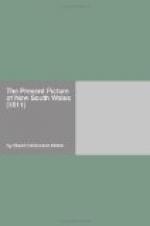that settlement, considering its magnitude. The
White House and Warehouses, which appear immediately
under that building, although a considerable distance
on this side, belong to Mr. Simeon Lord; they are built
of stone, and the dwelling-house is by far the most
magnificent in the colony. The road leading through
Barrack-square is the high road to Parramatta.
The house at the head of Government-wharf, shewing
four windows on the ground floor, is a Dry Storehouse
belonging to the crown, and is used for depositing
articles for barter, etc. in, which are sent
out by government for that purpose. The small
yellow house behind it belongs to government, and is
inhabited by Mr. John Gowen, one of his majesty’s
store-keepers in that settlement. The yellow
house, on the right of the Barrack-square, and having
nine windows in front on each floor, is an extensive
Government Granary, and was built of brick, plaistered
over, under the direction of his excellency Governor
Hunter. Attached to this building, on the right,
is a very useful Military Store; and, on the left,
a Store for the issue of Provisions. The red
house, to the right, built of brick, with two wings,
is the Female Orphan-house, which is a very convenient
building, and was purchased from Captain Kent, of the
royal navy, but great additions have been made to
it subsequent to its purchase. The long building
above the Orphan-house, of which only a part of the
front is seen, is built of brick, and belongs to Garnham
Blaxcell, Esq. whose zeal for the colony, and whose
industry, have equally entitled him to the esteem and
praise of all. The house a little to the right
of the Orphan-house, and appearing to have a wing,
is the Dwelling, and, attached to it, are the Warehouses
of Mr. James Underwood; they are built of brick, and
are extremely commodious and comfortable. The
building above is the Church, as the tower denotes;
it is built of stone, and has a peal of eight bells
therein, but they are not very harmonious. On
the right of the one road leading to the church, the
building with four windows and two doors in front,
and the erection above it, are two Government Store-houses,
built of brick and plaister; the first is generally
used for bonding of spirits in, for naval stores,
etc.; and the other for the reception of salt
provisions, when any arrive from England. The
Windmill on the hill is built of stone, and belongs
to government; and the building on the right, which
is continued in View, No. II. with a wall round
it, is built of stone, and forms part of the County
Gaol. In the fore ground, six of the Natives
are in the attitude of throwing the spear; two with
spears; one with a spear and helemon, or shield; and
two sitting down.—Of the dexterity with
which they hurl this weapon, some notice has been
taken in a preceding part of this sketch.




